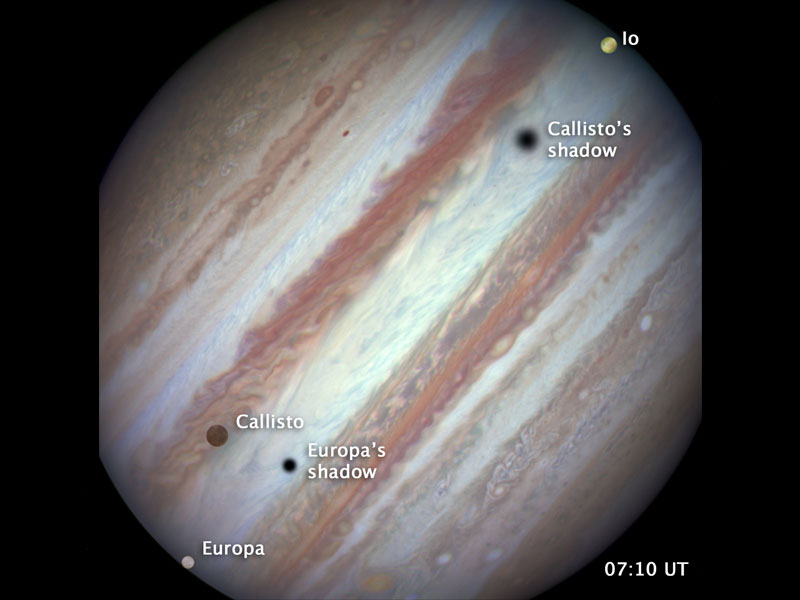https://solarsystem.nasa.gov/moons/jupiter-moons/io/overview/

Introduction
Jupiter's rocky moon Io is the most volcanically active world in the solar system, with hundreds of volcanoes, some erupting lava fountains dozens of miles (or kilometers) high. Io’s remarkable activity is the result of a tug-of-war between Jupiter's powerful gravity and smaller but precisely timed pulls from two neighboring moons that orbit farther from Jupiter – Europa and Ganymede.
In mythology, Io is a mortal woman transformed into a cow during a dispute between the Greek god Zeus – Jupiter in Roman mythology – and his wife, Hera – Juno to the Romans.
概要
木星的衛星艾奧是太陽系里火山活動最強烈的一個世界,有幾百座火山,有些火山噴發熔巖噴泉高達幾打英里(幾十千米)。艾奧異常的行為是木星強大的引力和兩個較小衛星之間精確定時拉鋸的結果,這兩顆衛星軌道距離木星較遠,分別是歐羅巴和伽倪墨得斯。
在古神話里,艾奧是個女凡人被變成了牛,原因是古希臘天神宙斯--羅馬神話里是朱庇特(譯注:木星的音譯)--和他的妻子赫拉之間產生了矛盾--羅馬人稱朱諾。
Size and Distance
A bit larger than Earth's Moon, Io is the third largest of Jupiter's moons, and the fifth one in distance from the planet.
大小和遠近
比地球的衛星月亮稍大,是木星的第三大衛星,距地球遠近上位列第五。
Orbit and Rotation
Although Io always points the same side toward Jupiter in its orbit around the giant planet, the large moons Europa and Ganymede perturb Io's orbit into an irregularly elliptical one. Thus, in its widely varying distances from Jupiter, Io is subjected to tremendous tidal forces.
These forces cause Io's surface to bulge up and down (or in and out) by as much as 330 feet (100 meters). Compare these tides on Io's solid surface to the tides on Earth's oceans. On Earth, in the place where tides are highest, the difference between low and high tides is only 60 feet (18 meters), and this is for water, not solid ground.
Io's orbit, keeping it at more or less a cozy 262,000 miles (422,000 kilometers) from Jupiter, cuts across the planet's powerful magnetic lines of force, thus turning Io into a electric generator. Io can develop 400,000 volts across itself and create an electric current of 3 million amperes. This current takes the path of least resistance along Jupiter's magnetic field lines to the planet's surface, creating lightning in Jupiter's upper atmosphere.
軌道和旋轉
盡管艾奧始終一面對著木星圍繞這個巨大的行星旋轉,但是較大的衛星歐羅巴和伽倪墨得斯干擾了艾奧的軌道導致形成了不規則的橢圓形。這樣以來,在和木星廣遠的間距變換中,艾奧受到巨大的潮汐力。
這些力導致艾奧表面忽起忽落(或者進和出)高達330英尺(100米)。對比一下艾奧固態表面的潮汐和地球上海洋的潮汐。在地球上,最高潮汐的地方,高低潮落差不過60英尺(18米),而且還是水,不是固態的陸地。
艾奧的軌道,使之處于或多或少距離木星262000英里(422000千米) 一個溫馨距離,切割這個行星強大的磁力線[譯注:木星的磁場是太陽系里最強的,比地球磁場強幾十倍,形成原因目前不特別清楚],致使艾奧成了一個發電機。艾奧自身能產生40萬伏的電壓,產生3百萬安的電流。這些電流沿著木星磁力線流經木星低阻抗表面,在木星高層大氣產生閃電。
Surface
The tidal forces generate a tremendous amount of heat within Io, keeping much of its subsurface crust in liquid form seeking any available escape route to the surface to relieve the pressure. Thus, the surface of Io is constantly renewing itself, filling in any impact craters with molten lava lakes and spreading smooth new floodplains of liquid rock. The composition of this material is not yet entirely clear, but theories suggest that it is largely molten sulfur and its compounds (which would account for the varied coloring) or silicate rock (which would better account for the apparent temperatures, which may be too hot to be sulfur). Sulfur dioxide is the primary constituent of a thin atmosphere on Io. It has no water to speak of, unlike the other, colder Galilean moons. Data from the Galileo spacecraft indicates that an iron core may form Io's center, thus giving Io its own magnetic field.
表面
潮汐力在艾奧內部產生巨大的熱量,導致它表面下的地殼成為液態,尋找任何到達表面的逃離路徑釋放壓力。這樣以來,艾奧表面會得到持續的更新,用巖漿填充任何隕石坑而且會產生光滑的液態熔巖洪泛平原。地質具體成分不太清楚,但理論假說認為大部分是熔化的硫磺及其硫化物(較好的解釋了表面不同的顏色構成)或硅酸鹽石頭(較好的解釋了顯而易見的表面溫度,都硫磺就太熱了)。艾奧稀薄的大氣主要組分主要是二氧化硫。不得不說,艾奧表面沒有水,不像其它較冷的伽利略衛星們[譯注:最初古天文學家伽利略發現了一系列的木星衛星,所以后來就有了這種稱呼]。伽利略太空船采集到的數據指出,艾奧中心可能存在鐵核,于是就擁有了自己的磁場。
Potential for Life
Constant volcanism and intense radiation make Io an unlikely destination for life.
潛在生命
持續的火山活動和強烈的輻射使得艾奧不太可能成為生命的落腳點。
Magnetosphere
As Jupiter rotates, it takes its magnetic field around with it, sweeping past Io and stripping off about 1 ton (1,000 kilograms) of Io's material every second. This material becomes ionized in the magnetic field and forms a doughnut-shaped cloud of intense radiation referred to as a plasma torus. Some of the ions are pulled into Jupiter's atmosphere along the magnetic lines of force and create auroras in the planet's upper atmosphere. It is the ions escaping from this torus that inflate Jupiter's magnetosphere to over twice the size we would expect.
磁圈
伴隨著木星自轉,木星的磁場包圍了艾奧,清掃艾奧,平均每秒從艾奧掠走大約1噸(1千千克)物質。這些物質在磁場里電離,形成面包圈狀的離子云,具有強烈的輻射,稱之為等離子圓環。一些離子沿著磁力線被拉入木星大氣,在木星上空產生極光。這些逃離圓環的離子導致木星磁圈膨脹,比我們預期大小大了一倍不止。
Discovery
Io was discovered on Jan. 8, 1610 by Galileo Galilei. The discovery, along with three other Jovian moons, was the first time a moon was discovered orbiting a planet other than Earth. The discovery of the four Galilean satellites eventually led to the understanding that planets in our solar system orbit the Sun, instead of our solar system revolving around Earth. Galileo apparently had observed Io on Jan. 7, 1610, but had been unable to differentiate between Io and Europa until the next night.
Galileo originally called Jupiter's moons the Medicean planets, after the powerful Italian Medici family and referred to the individual moons numerically as I, II, III, and IV. Galileo's naming system would be used for a couple of centuries.
It wouldn't be until the mid-1800s that the names of the Galilean moons, Io, Europa, Ganymede, and Callisto, would be officially adopted, and only after it became apparent that naming moons by number would be very confusing as new additional moons were being discovered.
In mythology, Io is a mortal woman transformed into a cow during a marital dispute between the Greek god Zeus—Jupiter in Roman mythology—and his wife, Juno. NASA’s Juno mission is named in honor of Juno who could peer through the clouds and expose her husband’s wrongdoings. The spacecraft also peers through clouds to reveal Jupiter’s secrets.
發現史
艾奧在1610年元月8日被伽利略伽利雷發現。和其它三個木星的衛星一起被發現的,這是首次發現地球之外的行星擁有自己環繞的衛星。伽利略四衛星的發現最終導致人類認識到太陽系里的行星們圍著太陽轉,而不是太陽系圍著地球轉。伽利略顯然于1610年元月7日就發現了艾奧,但是直到第二天晚上才能把它和歐羅巴區分開。

伽利略最初稱木星的衛星為美第奇家族行星,意大利美第奇家族之后,這些獨立的衛星才被命名為I, II, III和IV。伽利略命名的體系會被沿用幾個世紀。
直到18世紀中期伽利略衛星的艾奧,卡利斯托,歐羅巴和伽倪墨得斯幾個名字才被官方采納,因為隨著更多衛星被發現,原來以數字命名衛星的做法非常令人費解。
在古神話里,古希臘天神宙斯--羅馬神話里稱朱庇特--和他的妻子朱諾之間的一次婚姻矛盾導致凡人艾奧[譯注:以漢語文化的視角來看,神仙宙斯有婚外情凡人艾奧]變成了牛。美國航空航天局的朱諾之旅為了向朱諾女神表達敬意特此命名,寓意是朱諾能看透云層揭露其丈夫的錯誤行為。該太空船也能透過云層去揭示木星的秘密。